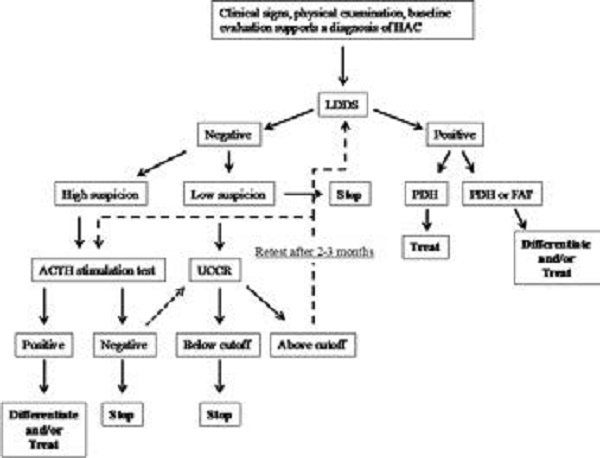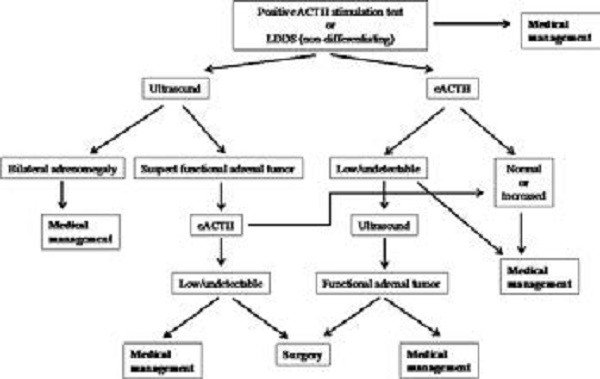But It Has to be Cushing’s… Challenges in Diagnosing Canine Hyperadrenocorticism
J. Fletcher
Veterinary Clinical Sciences, Louisiana State University, Baton Rouge, LA, USA
Diagnosing Hyperadrenocorticism (HAC)
Testing is divided into screening (confirming the presence of HAC) and differentiation (pituitary dependent hyperadrenocorticism or functional adrenal tumor). It may be necessary to perform multiple screening tests or repeat testing at a later date in order to confirm the diagnosis in early or more challenging cases.
Screening Tests
Urine Cortisol to Creatinine Ratio (UCCR)
- Most commonly used to rule out HAC when there is a low clinical index of suspicion
- False-positive results are common because stress/non-adrenal illness can cause an increase in the UCCR
- Recommend performing a low-dose dexamethasone suppression test or ACTH stimulation test after obtaining a positive UCCR because of the lack of specificity (high risk of false-positive results)
Protocol
- Client/owner collects a urine sample at home. Urine should not be collected in the hospital or within 48–72 hours of a clinic/hospital visit because the stress of a clinic/hospital visit has been shown to increase the UCCR and increases the possibility of a false-positive result.
- Typically recommend first urination in the morning
- Using pooled samples (3 consecutive days) may provide a more representative result
Interpretation
- Normal ratio (below the laboratory cut-off) - HAC is very unlikely
- Abnormal ratio (above the laboratory cut-off) - recommend performing another screening test (low-dose dexamethasone suppression test or ACTH stimulation test) to confirm HAC prior to initiating therapy
Low-Dose Dexamethasone Suppression Test (LDDS)
- Highly sensitive test
- Greater chance of false-positive result with non-adrenal illness than ACTH stimulation test (not a significant concern if screening an appropriate population)
- Can also serve as a differentiating test if positive and meet criteria for pituitary dependent HAC
Protocol
- Collect baseline blood sample
- Administer 0.01–0.015 mg/kg of dexamethasone or dexamethasone SP intravenously (preferred) or intramuscularly
- Collect blood samples at 4 and 8 hours after the administration of dexamethasone
Interpretation
- Normal dog - complete suppression at 4 and 8 hours
- Consistent with HAC - lack of suppression at 4 and/ or 8 hours
- Lack of suppression does not confirm the presence of a functional adrenal tumor (FAT)
- Consistent with pituitary dependent hyperadrenocorticism (PDH)
- Suppression at 4 hours with an escape at 8 hours
- Suppression at 4 and/or 8 hours to less than 50% of the baseline cortisol concentration
ACTH Stimulation Test
- Less-sensitive test than LDDS test
- Less chance of false-positive result than LDDS test
- Only test that can diagnose iatrogenic HAC
Protocol
- Obtain baseline blood sample
- Administer synthetic ACTH (cosyntropin or tetracosactrin) intravenously at a dose of 5 μg/kg (maximum dose 250 μg/dog)
- Obtain blood sample 1 hour after administering ACTH (post-ACTH). Some clinicians also collect a 2-hour post-ACTH sample in order not to miss (get a false-negative result) the small percentage of dogs that have peak cortisol secretion after 2 hours rather than 1 hour
Interpretation
- Normal dog - post-ACTH cortisol concentration below the laboratory cut-off
- Consistent with HAC - post ACTH cortisol concentration above the laboratory cut-off
Basal or Resting Cortisol Concentration
No Diagnostic Value for HAC
Below is the author’s approach to screening for HAC. The decision to perform additional screening tests following a negative LDDS test is based on the degree of clinical suspicion. In situations of high clinical suspicion, it is important to remember that no screening test is perfect. It may be necessary to perform multiple screening tests or repeat testing at a later date in order to confirm the diagnosis in early or more challenging cases.
Figure 1

Differentiating Tests
High-dose dexamethasone suppression test protocol (same as LDDS test but with higher dose of dexamethasone):
- Collect baseline blood sample
- Administer 0.1 mg/kg of dexamethasone or dexamethasone SP intravenously (preferred) or intramuscularly
- Collect blood samples at 4 and 8 hours after the administration of dexamethasone
- Results can support the presence of PDH
- Results cannot confirm the presence of a FAT
Interpretation
- Consistent with PDH
- Complete suppression at 4 and/or 8 hours
- Cortisol concentrations less than 50% of baseline concentration at 4 and/or 8 hours
- Lack of suppression does not confirm the presence of a FAT.
Endogenous ACTH Concentration
- Single blood sample
- Immediately centrifuge and separate plasma from cells and freeze until shipping. Ship overnight on ice. This will minimize the amount of degradation, which is a concern with inappropriate sample handling.
- Possible to confirm PDH or FAT
Interpretation
- Consistent with PDHACTH concentration is normal or increased
- Consistent with presence of a FATACTH is low or undetectable
Ultrasonography
- Evaluate size and appearance of adrenal glands
- Can confirm presence of an adrenal tumor
- Aid in the detection of concurrent illness
Below is the author’s approach to differentiating PDH from FAT. The author believes it is important to confirm a FAT with ultrasound and endogenous ACTH prior to surgery because asymmetric adrenal gland enlargement and nodular hyperplasia is not uncommon with PDH.
Figure 2

Occult Hyperadrenocorticism
Historically known as “atypical hyperadrenocorticism” Clinical signs, physical examination findings, and clinicopathologic findings support a diagnosis of HAC, but the UCCR, LDDS test, and ACTH stimulation test fail to support the diagnosis.
It has not been proven that sex hormones are responsible for this syndrome.
Reasons to Suspect Occult HAC
- Clinical signs consistent with HAC
- Cortisol concentrations on ACTH stimulation test and
LDDS Tests Are Below the Reference Interval
- Presence of an adrenal tumor supports the diagnosis
- Lack of tumor does not rule out diagnosis
If clinical signs are mild, retest for classical HAC when signs worsen.
If clinical signs are moderate/severe, perform an abdominal ultrasound.
Normal adrenal glands - reconsider diagnosis
Bilateral adrenomegaly - consider confirming PDH with cross-sectional imaging
- May be mild or early HAC
- May be food-dependent HAC (considered rare)
- Specificity of sex hormone panel is low - interpret with caution
References
1. Behrend E.N., Melian C. Hyperadrenocorticism in dogs. In J. Rand (Ed.). Clinical Endocrinology of Companion Animals. Ames, Iowa: John Wiley & Sons, Inc; 2013.
2. Behrend E.N. Canine hyperadrenocorticism. In EC Feldman, RW Nelson, C Reusch, JC Scott-Moncrieff (Eds). Canine and Feline Endocrinology. Elsevier Health Sciences; 2014.
3. Behrend E.N., Kooistra H.S., Nelson R., Reusch C.E., Scott-Moncrieff J.C. Diagnosis of spontaneous canine hyperadrenocorticism: 2012 ACVIM consensus statement (small animal). J Vet Intern Med; 2013.